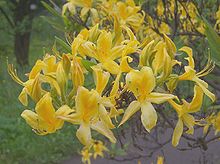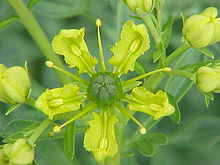- Chervona Ruta
-
For other uses, see Chervona Ruta (disambiguation).
Chervona Ruta (Ukrainian: Червона рута, rue – heady plant) is a flower, but also part of the Ukrainian culture related to the holiday of Ivan Kupala Day. According to the legend, still respected in Carpathian mountains and Bukovina, rue is a yellow flower which turns red only for a couple of minutes on the night of Ivan Kupala. The girls who will find the flower will be happy in love.[1]
Contents
Legend
"Chervona" is translated from Ukrainian as red. The ruta flower has yellow blooms, but according to legend, on the eve of Ivan Kupala Day, the flower turns red for a very short time on the eve of the Summer solstice (celebrated on June 23 or sometimes July 7).
The flower brings fortune to the person who finds it. In various versions of the tale, the fern flower brings luck, wealth, or the ability to understand animal speech. However, the flower is closely guarded by evil spirits and anyone who finds the flower will have access to earthly riches, which have never benefited anyone, so the decision to pick the flower or leave it alone is left up to the individual.
Sofia Rotaru has a song with the same name. in one of her interviews, she explained the etymology of the term in following words: "Ruta is a yellow flower, which becomes red on the night of the Ivan Kupala Day".[2][unreliable source?]
Etymology
"Chervonyi" - is an old Slavonic word. The transformation of the meaning of the adjective "krasnyi" (red) has an interesting history. The proverbs "An izba is red judging by its corners", "A debt is red by its payment", "Red girl" mean "red", "good" as to beautify from the Slavic word "krasa" - beauty. In such a way, when the Kievan Rus' was also called Krasnaya Rus', they meant that it was "beautiful" Rus'. For the color notation proper, the Slavic languages used the word "chervonyi". In Russian language, one can still see the link in the word "chervontsy" (bank notes worth of 10 roubles of red colour). A big number of linguists consider that namely through the use in the financial field, the initial sense of the term was somewhat alterated. Hence, "Chervona Ruta" does not need a translation. One can eventually russify "Chervonaya Ruta", which remains solely theoretical.[clarification needed]
Scientific explication
- Rue (Latin: Ruta) — is a name for the plant from the Rutaceae family. There are about 60 known types of rutas, wildly growing in the Mediterranean regions, Western and Middle Asia. One type of rue grows on the territory of the former USSR - Common Rue, a sweet-scented Herb-of-grace which grows in Crimea, on the rocky slopes. Common Rue (Ruta graveolens L.) — is the most common type, a subshrub, naked, greyish green suffrutex plant, up to 40 cm in height. Its leaves are pinnately dissected an it has a corymb inflorescence in the form of panicle.
- According to a different opinion, Chervona Ruta means Golden and/or Yellow Rhododendron.
See also
References
- ^ "Премьера на "Интере". В документальной ленте о певице старые друзья раскорют секрет ее успеха". Сегодня. http://www.segodnya.ua/news/794449.html. Retrieved 2008-02-18.
- ^ "Обсуждение значения и происхождения термина "Червона рута"". Официальный фан клуб Софии Ротару "Фортуна". http://www.fortuna-rotaru.com/lofiversion/index.php?t1013.html. Retrieved 2008-02-11.
Categories:- Ukrainian culture
- Russian culture
- Soviet culture
- Slavic culture
- Belarusian culture
Wikimedia Foundation. 2010.



